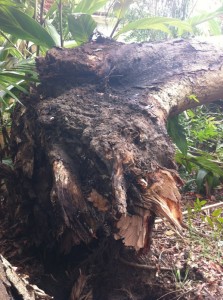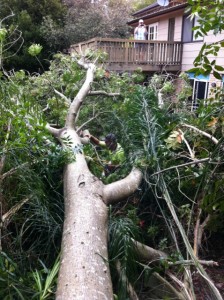With lots of rain and heavy wind, trees with poor structure are prone to falling over.
Of course a strong enough wind will damage even the strongest of trees. But the first to go will be those with poor structure. Namely those trees situated in loose ground or those with poor trunk or branch attachments and heavy or dense foliage.
Poor attachments usually occur at structural faults such as multiple stems coming from the same point or branches with steep attachment angles (included forks) – where the steep angle causes the tree to push against the branch or other stem as it grows -pushing it out.
Another issue can be dense heavy foliage. Foliage (depending on species) can weigh as much or more than the tree itself. The pressure from wind on foliage can create huge forces. Dense foliage acts as a sail for the wind to blow against (sail effect).
Tree pruning to remove structural defects and to thin trees to reduce the sail effect is a great way to maintain and keep your tree strong during extreme weather events.

Included trunk with poor attachment and crown of dense heavy foliage = property damage

This is why an annual tree hazard assessment is a vital part of your maintaining your home.
Prevent tree removal – pre-empt with tree care!

